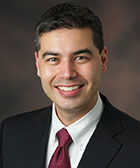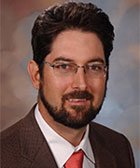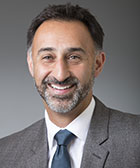Attention: Restrictions on use of AUA, AUAER, and UCF content in third party applications, including artificial intelligence technologies, such as large language models and generative AI.
You are prohibited from using or uploading content you accessed through this website into external applications, bots, software, or websites, including those using artificial intelligence technologies and infrastructure, including deep learning, machine learning and large language models and generative AI.
2018 Data Grant Recipients

Michael H. Johnson, MD
Assistant Professor of Urology and Oncology, Brady Urological Institute at Johns Hopkins University School of Medicine
Project Title: Broadband Internet Access and Urologic Cancer Mortality: Developing Strategic Policies for Urologic Telemedicine Services Using Spatial and Regression Analyses
Dr. Johnson, Dr. Philip Pierorazio and Ms. Paige Nichols will utilize federal data on broadband internet access, rurality, urologist density, and cancer mortality to establish geospatial relationships between internet access and urologic cancer mortality for all counties in the United States. State-level data on telemedicine regulations will then be incorporated into their model to predict which U.S. counties are best suited to utilize urologic telemedicine services.

Jeremy B. Myers, MD
Associate Professor of Urology, University of Utah Health Co-Director for the Center of Reconstructive Urology and Men's Health
Project Title: Long‐Term Complications from Treatments of Prostate Cancer: An Analysis of the Utah Population Database
Dr. Myers and Dr. Darshan Patel will study short and long term (>10 year) complications associated with localized prostate cancer treatments including radiotherapy, surgery, or both using the Utah Population Database (UPDB). This project uses a unique population based cohort that overcomes several limitations of prior SEER-Medicare cohorts. Key objectives include defining the long-term morbidity and mortality associated with treatment specific complications (incontinence, urinary obstruction, rectal complications, secondary malignancies, etc.) compared to a population control without prostate cancer using links within UPDB to various datasets. Findings from this study will help provide patients with the necessary information to make an informed decision about their treatment.

Paige E. Nichols
Medical Student, Johns Hopkins University School of Medicine
Project Title: Broadband Internet Access and Urologic Cancer Mortality: Developing Strategic Policies for Urologic Telemedicine Services Using Spatial and Regression Analyses
Ms. Nichols, Dr. Philip Pierorazio and Dr. Michael Johnson will utilize federal data on broadband internet access, rurality, urologist density, and cancer mortality to establish geospatial relationships between internet access and urologic cancer mortality for all counties in the United States. State-level data on telemedicine regulations will then be incorporated into their model to predict which U.S. counties are best suited to utilize urologic telemedicine services.

Vernon M. Pais, Jr., MD
Associate Professor of Surgery, Geisel School of Medicine at Dartmouth
Project Title: Evaluation of opioid prescribing among kidney stone patients
Nationwide efforts to address narcotic overuse include delineation of medical exposure to opioids, typically driven by desire to ameliorate pain. Nephrolithiasis is thus of particular interest as it is recognized as a common source of acute severe pain, and further has a high recurrence rate. Thus, those suffering with stones are at risk of repeated exposure to opioid analgesics. An understanding of opioid dispensing and utilization in this population is paramount to informing responsible prescribing by urologists. This data grant will seek to evaluate current opioid use and risk factors for repeated exposures in a national cohort of stone formers.

Darshan P. Patel, MD
Resident Physician in Urology, University of Utah Health
Project Title: Long‐Term Complications from Treatments of Prostate Cancer: An Analysis of the Utah Population Database
Dr. Jeremy Myers and Dr. Patel will study short and long term (>10 year) complications associated with localized prostate cancer treatments including radiotherapy, surgery, or both using the Utah Population Database (UPDB). This project uses a unique population based cohort that overcomes several limitations of prior SEER-Medicare cohorts. Key objectives include defining the long-term morbidity and mortality associated with treatment specific complications (incontinence, urinary obstruction, rectal complications, secondary malignancies, etc.) compared to a population control without prostate cancer using links within UPDB to various datasets. Findings from this study will help provide patients with the necessary information to make an informed decision about their treatment.

Philip M. Pierorazio, MD
Associate Professor of Urology and Oncology, Director of the Division of Testicular Cancer, and Director of Social Media, Brady Urological Institute at Johns Hopkins University School of Medicine
Project Title: Broadband Internet Access and Urologic Cancer Mortality: Developing Strategic Policies for Urologic Telemedicine Services Using Spatial and Regression Analyses
Dr. Pierorazio, Dr. Michael Johnson and Ms. Paige Nichols will utilize federal data on broadband internet access, rurality, urologist density, and cancer mortality to establish geospatial relationships between internet access and urologic cancer mortality for all counties in the United States. State-level data on telemedicine regulations will then be incorporated into their model to predict which U.S. counties are best suited to utilize urologic telemedicine services.

Maxine Sun, PhD, MPH
Research Scientist with the Center of Surgery and Public Health Division, Brigham and Women's Hospital Lank Center for Genitourinary Oncology at the Dana-Farber Cancer Institute
Prostate cancer (PCa) contributes to the high economic burden in the US, and ranks among the top five cancers in contribution to national expenditures. As part of the initiative to reduce waste and improve spending in urology, the investigation of spending patterns of men diagnosed with PCa, with a special focus on those with the highest expenses, can improve understanding of what and who contributes to higher costs in the context of PCa. We expect that our findings will shed light on these cost drivers as well as aid providers and policymakers in optimizing the value of care for men with PCa.
